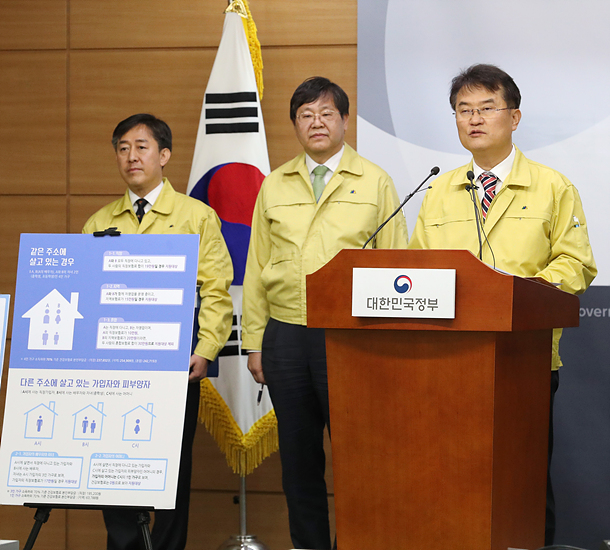Emergency relief grant to be determined based on March’s health insurance payment

Government officials explain the details of the emergency relief grant on Friday at the Sejong government complex.
According to the government on Friday those whose insurance is partially covered by their employers and live alone will be eligible for the government’s check if their health insurance payment was 88,000 won ($71) or less last month. For a family of two the maximum limit will be 150,000 won, for a family of three 195,000 won and for a family of four 237,000 won. For a family of five it is 286,647 won.
For regional subscribers, who are mostly self-employed or those that are retired, the maximum ceiling to be eligible for the government’s financial handout is 63,778 won for single households, 147,928 won for a household of two, 203,127 won for a family of three and 254,909 won for a family of four. For a family of five the maximum limit is 308,952 won.
The government, however, said it will not include those with massive wealth even if they meet the insurance criteria.
It said the details to the massive wealth limit will be announced at a later date.
“For small business owners and the self-employed whose incomes have shrunk significantly recently but wasn’t reflected in [last month’s] insurance payment, the government plans to come up with various reinforced measures so that their income status when applying [for the government funds] can be taken into account in the local governments’ final decisions,” said Yoon Jong-in, vice minister of the interior and safety.
The government said it has decided to use the health insurance payment in determining families that will be eligible for the government grants because it is data that is available at hand.
“On average it takes two months in determining the households that will be eligible when using the initially considered investigation system in assessing incomes,” said Yang Sung-il, head of the health and welfare policy bureau at the Ministry of Health and Welfare. “However, the national health insurance payment is the most recent data [that can be used immediately].”
President Moon Jae-in on Monday said the government will grant cash-equivalent grants to 70 percent of households in the country or roughly 14 million families to cope with the economic impact of the coronavirus pandemic.
A person living alone will receive a 400,000 won grant in a single payment while a family of two will receive 600,000 won, three 800,000 won and a family of four 1 million won.
President Moon said the government will work to see that the grant be distributed to the 70 percent of households by mid-May.
The government said the funding on the relief grant will be made through a second supplementary budget.
While the total amount is estimated to be 9.1 trillion won, the central government will fund 7.1 trillion won while the 2 trillion won will be covered by the local government.
The government said the 7.1 trillion won will be created through a second supplementary budget that it plans to get approved by the National Assembly after the April 15 general elections.
However, the government on Monday did not give details as to what standard will be applied in determining households that will be eligible for the grant other than that it will be the lower 70 percent, which generated confusion and criticism that the government was rushing the grant without proper evaluation.
There has also been speculation that the government will be excluding those that paid comprehensive real estate taxes as they are considered wealthy.
The comprehensive tax is only applied to those who own a single real estate property, of which the government-assessed value exceeds 900 million won or 600 million won on multiple real-estate properties.
According to the Land Ministry, those that had to pay the comprehensive tax on a single apartment whose assessed value exceeded 900 million won last year amounted to 218,124 households. Of that total 93 percent are in Seoul or 203,174. In the richest neighborhood of Gangnam, southern Seoul, 69,441 households were billed with the comprehensive real estate tax.
BY LEE HO-JEONG [lee.hojeong@joongang.co.kr]










with the Korea JoongAng Daily
To write comments, please log in to one of the accounts.
Standards Board Policy (0/250자)